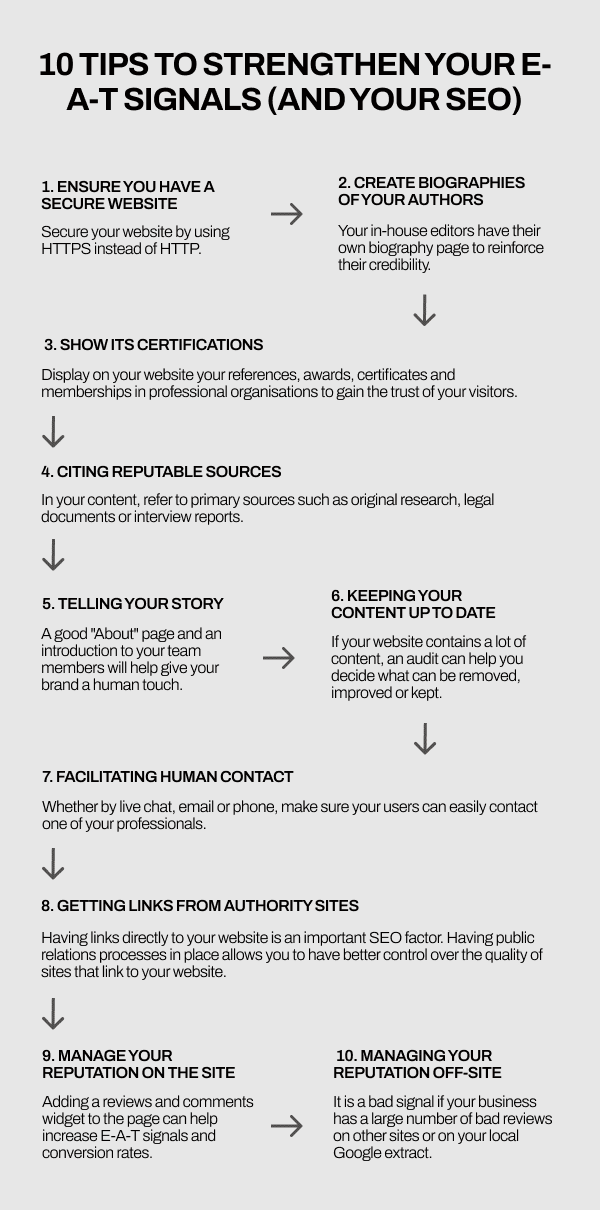Content Marketing Strategist
E-A-T & SEO: How does Google evaluate the quality of your content
Content Marketing Strategist
Between 2010 and 2020, the quantity of information available on the Internet multiplied by a factor of 30. This staggering growth led to the emergence of a number of major issues in the 21st century, in particular the explosion of fake news. The problem lies in not just our access to an ever-increasing amount of information, but also in the difficulty of evaluating the reliability of sources. Faced with this uncertainty, we need to feel we can trust what we are being told now more than ever before.
So how can we figure out what’s reliable? How can we separate what’s true from what’s fake?
Google is offering its own solution:
E-A-T, which stands for Expertise, Authoritativeness, Trustworthiness
In this article, we’ll present what E-A-T is before tackling the reasons this solution might affect your company and help with advantageous positioning. We’ll then offer 10 smart tips to strengthen your E-A-T signals and conclude with a discussion of the future of positioning factors.
What is E-A-T?
E-A-T is a bundle of criteria used by Google to determine the quality of a piece of content. It came into effect in 2018, during the update of Google Medic, and its main goal was to fight against the spread of fake news and improve user experience.
These criteria comprise three dimensions:
- Expertise
- Authoritativeness
- Trustworthiness
Expertise
Expertise refers to the depth and extent of the understanding displayed about a subject. The more you present yourself as an expert in your field, the more likely it is that Google will rank your site at the top of search results for terms related to your field of expertise.
Authoritativeness
Authoritativeness refers to the recognition your website has within its particular niche. If you are recognized as experts in your industry and people tend to turn to you when they have questions relating to your sector of activity, then this is a sign you’re an authoritative figure within your field.
Trustworthiness
Trustworthiness refers to the trust YOU inspire in others as an author. It indicates whether users can trust what they read on the page they are consulting.
A link may be considered spam in Google’s view if it prompts users to click on an ad or buy products and services.
This means you need to ensure that all the content on your page comes from an authoritative source. It also means you need to ensure that everything appearing on your website was written by someone who is knowledgeable about the subject, and not by someone who is merely motivating visitors to click on ads or buy products and services, which Google considers to be spam!
Is your brand affected by E-A-T?
To be credible amongst their targets, brands must not only concern themselves with their E-A-T score but also with integrating this philosophy into their content cr-E-A-T-ion processes.
Providing reliable information should always be your goal on the Internet: Implementing elements that testify to the validity of that information will only strengthen its reliability and, therefore, the performance of your webpages. Respecting best practices when it comes to E-A-T generally allows brands to benefit from more visibility, especially through the sharing of their articles, which will be presented as authoritative content.
However, some industries are more likely to generate misleading or unreliable information.
Thus when the update of Medic was launched in 2018, SEO solutions specialists Moz recorded a jump in traffic by up to 70% to certain webpages. The sector most affected by this phenomenon was health, because platforms in this industry address topics in the Your Money Your Life category.
Your Money Your Life topics
What is the nature of YMYL subjects?
Actually, this term is applied to information that could have a direct effect on the lives of web users. It brings together all activities related to health (medical offices, for example), security, banking services and e-commerce, amongst others.
To find out whether the subjects addressed in your industry are considered part of YMYL by Google, you simply need to ask yourself this question:
Does my site include pages presenting information that could cause harm to someone if that information turns out to be misleading or incorrect?
If the answer is yes, then E-A-T indicators are even more crucial for your business and its SEO performance.
Is E-A-T a factor when it comes to positioning?
Strictly speaking, E-A-T is not a factor when it comes to positioning. E-A-T is instead more of a concept. It is therefore not directly measurable by Google, unlike the quantity of external links or how fast your page loads, for example.
That said, it’s clear that E-A-T influences the positioning of your content, because it informs Google about the quality and reliability of the information you are communicating. Given that content is one of the basic criteria that determine your positioning, E-A-T is therefore an important evaluation criterion to consider. It’s just that it isn’t explicitly a positioning factor.
How do E-A-T factors influence your SEO results?
Remember that Google’s algorithm sorts for relevance: Its objective is always to provide the search results that are most in line with the user’s search intention.
When browsing your website, Google’s indexing bots are able to evaluate the presence of E-A-T signals and attribute them a low or high value. As you might have gathered, the central idea of E-A-T is to offer more visibility to high-quality pages and reduce visibility for lower-quality pages.
So lower-quality E-A-T signals could cause your organic positioning in Google to fall and, therefore, lead to a reduction in traffic to your website.
But be careful about jumping to conclusions too quickly! With SEO, fluctuations in traffic are common (and normal!) and are often explained by a number of factors: changes in algorithms, variations in user demand, more aggressive competition, etc.
The best way to determine the state of your website is to perform a technical audit and content analysis. These will enable you to identify the technical obstacles that are likely to affect your site’s positioning and evaluate the performance of your pages with regard to E-A-T criteria.
Ten tips for improving your E-A-T signals
To improve the quality of a page, you must verify whether it responds adequately to Google’s requirements.
Here are the 10 main levers to activate to achieve this:

The application of these tips may help you gain credibility in the eyes of your users. They will be of particular interest if your website is already conforming to best practices in SEO. On the other hand, if your website is experiencing positioning issues, you need to prioritize resolving this problem, then deal with your E-A-T signals later.
What is the future of positioning factors?
For the past few years, major changes in SEO have been observed in Google’s algorithms. In 2021, Core Web Vitals combined with the family of positioning factors and new surprises are certainly to come in future updates to the search engine.
You should understand that these changes to the algorithms are occurring for a reason: Faced with the rapid growth of the quantity of information available on the web, Google must constantly make adjustments in order to ensure the relevancy of its search results for users. Thus, user experience will take up more and more space when it comes to the webpage evaluation process, and the digital giant will adopt a standard with a clear message:
Content is king!
—
In need of advice or tools to improve your SEO positioning?
If so, we encourage you to read (or re-read) our article on the five myths of SEO, which presents five persistent yet incorrect ideas that may be harming your positioning in search engines. If you need more in-depth and personalized guidance, don’t hesitate to reach out to our SEO experts or take a look at our diverse range of content marketing services.













